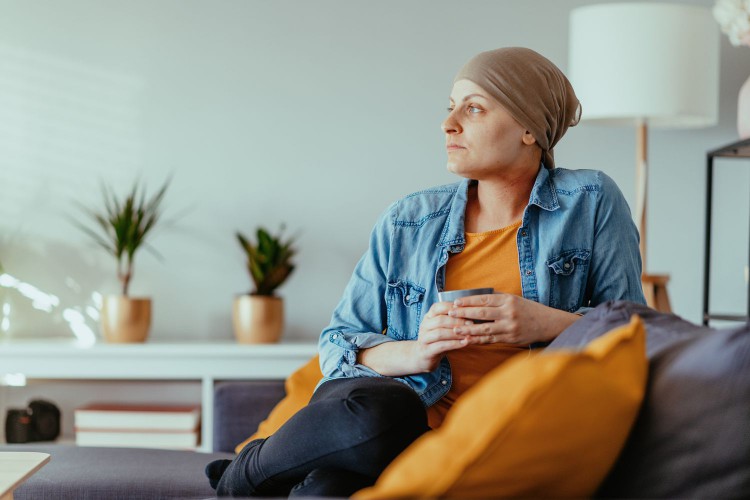- New cancer diagnoses—particularly gastrointestinal cancers like colorectal and pancreatic—are on the rise among people under 50, new research shows.
- Between 2010 and 2019, the rates of early-onset cancer increased by 0.74%.
- Early-onset gastrointestinal cancers not only had the greatest increase in new cases, but also the fastest increase.

Drazen_/Getty Images
Gastrointestinal cancers—including colorectal, pancreatic, and bile duct—are being diagnosed more often and at a faster rate in younger adults than they were a decade ago, according to a new report.
The study, published earlier this month in JAMA Network Open, sought to compare the cancer incidence rates—or the number of new cases diagnosed—in people younger than 50 years old between 2010 and 2019. Over a decade, the rates of early-onset cancer increased by 0.74%.
During that time period, early-onset gastrointestinal cancers not only had the greatest increase in the number of new cases (from 6,431 cases in 2010 to 7,383 cases in 2019, or a 14.8% increase), but also had the fastest increase, rising at a rate of 2.16% per year.
This new data, though not necessarily surprising, supports other recent research on the rise of gastrointestinal cancers in younger populations, according to Jake Stein, MD, MPH, assistant professor of oncology and health services researcher at the University of North Carolina School of Medicine.
“Many in the medical community have known about the increase in GI and specifically colorectal cancer in younger patients for some time,” Stein, who was not affiliated with the new research, told Health in an email. “But this study gives clear data to show those trends are real.”
And it’s not just early-onset gastrointestinal cancers that are on the rise—the new study also identified increases in the rates of breast, urinary system, and reproductive system cancers.
Here’s what to know about this increase in early-onset cancers, and what you can do to mitigate your risk.
An Increase in Multiple Cancers Among Younger People
In order to estimate the prevalence of early-onset cancer in the U.S., the study authors used data from the National Cancer Institute’s Surveillance, Epidemiology, and End Results (SEER) program, which includes information from about 26% of Americans.
Using this incredibly large data set, the researchers examined reported cases of cancer in people under 50—technically known as early-onset cancer—and matched them with individuals’ self-reported gender and race. They also collected data on age group and type of cancer.
In total, they found 562,145 patients were diagnosed with early-onset cancer between 2010 and 2019. The majority were between the ages of 40 and 49, and were women.
The study authors cataloged 56,051 new early-onset cancer cases in 2010, and an additional 56,468 in 2019. Those extra 417 cases in 2019 amounted to a 0.74% increase over the course of the decade.
In particular, incidence rates of early-onset gastrointestinal cancers grew the most between 2010 and 2019, followed by urinary system cancers and female reproductive system cancers, such as cervical or ovarian cancer.
For gastrointestinal early-onset cancers, the most commonly reported were colon, rectal, stomach, and pancreatic cancer. However, the incidence rates for appendix, intrahepatic bile duct, and pancreas cancers grew the fastest over the course of the decade.
Breast cancer also stood out to researchers—that cancer type had the highest number of new early-onset cases in 2019 specifically.
The study offers a “big picture, or a bird’s eye view of what’s going on,” explained Kala Visvanathan, MD, MHS, professor of epidemiology and oncology at the Johns Hopkins Bloomberg School of Public Health. However, there are still some missing pieces.
For one, the study doesn’t touch on mortality rates, or how many young people died from cancer, Visvanathan said.
It also doesn’t include data on “individual people—meaning, what their risk factors are, including family history, or their diet or their lifestyle,” she told Health.
This makes it challenging to determine why early-onset cancer rates increased between 2010 and 2019. However, it’s likely that lifestyle and behavioral factors at least in part explain the rise.
“The reasons for the increase remain poorly understood,” Matthew Kulke MD, chief of hematology and medical oncology at Boston Medical Center and Boston University, told Health in an email. “Known risk factors such as obesity, diabetes, and lack of physical exercise may be playing a role although it is certainly possible there are other factors that we have not yet identified.”
Diet—particularly high consumption of alcohol, processed foods, and red meat—could also be behind the increase, Stein added.
Alarming Results, for Some More Than Others
In addition to the different types of cancer researchers saw, they also emphasized that incidence of early-onset cancers changed dramatically depending on different demographic factors.
Above the average 0.74% increase in early-onset cancer cases, women saw a 4.35% increase in incidence over the course of the 2010s. The opposite was true for men—early-onset cancer cases actually became less frequent, decreasing by 4.91%.
The differences grew even greater when researchers broke down results by race. People who were Asian or Pacific Islander, or Hispanic, saw increases in early-onset cancer rates in the double-digits (32.3% and 27.6%, respectively). Indigenous Americans also saw an increase of 2.3%, while the rates of early-onset cancer decreased for both White and Black Americans.
Differences were found among age groups, as well. People ages 30 to 39 saw the greatest increase in early-onset cancer rates, while cancer incidence rates remained stagnant for the 40- to 49-year old age group, and declined for people over age 50.
“If you look at the age, what you are seeing is that increase is in even younger individuals, that 30 to 39 group,” Visvanathan said. “To me, that’s concerning.”
Again, it’s not fully clear why early-onset cancer cases were split by gender, ethnic, or age differences. As important as it is to address those disparities, even groups that saw decreases aren’t out of the woods, Visvanathan added.
“Everyone’s focused on the ones that have changed, but they don’t look at where the baseline still is,” she said, adding that stagnant or slightly-decreasing incidence rates still paint an alarming picture.
It’s also important to remember that even with early-onset cancer cases seemingly on the rise, these still pale in comparison to the cancer incidence rates associated with older people.
SEER data from 2013 to 2017 found that 350 out of 100,000 people aged 45 to 49 develop cancer. That jumps to more than 1,000 per 100,000 people in age groups 60 years and older.
Cancer Is Not Exclusively an Older Person’s Disease
More than anything, studies like these are important so that healthcare professionals, policymakers, and even individual people can have a better understanding of cancer risks.
Not every person should start cancer screening at a young age, but it is important that those who may be at a higher risk due to family history, genetics, race, or other factors, don’t delay that conversation with their doctor, Visvanathan said.
Regarding gastrointestinal cancers and colorectal cancer specifically, the U.S. Preventive Services Task Force lowered the recommended age of colorectal cancer screening from 50 to 45 in 2021, due to the rise in cases among younger people. It’s possible that in the years to come, other screening recommendations—possibly for gastrointestinal or breast cancers—will be similarly adjusted.
“We’re not yet to the point of saying we should be doing screening tests such as mammograms or colonoscopies in younger patients, but future studies can help explore that further,” Stein said.
If guidelines are reevaluated or updated, it’s crucial that “members of under-represented groups, who already face barriers to health care access, are aware of these screening guidelines and have access to cancer screening,” Kulke added.
But beyond big picture recommendations, the study should also serve to raise awareness about the prevalence of early-onset cancer, Visvanathan said. In other words, people should remember that “cancer is not exclusively a disease of older people,” said Stein.
This will be especially important to keep in mind as researchers look into the impact that COVID may have had on cancer rates in the U.S. The data used in this study ended in 2019, and it’s possible that in the years since, early-onset cancer rates have grown even more.
Many of the factors that can up cancer risk—obesity, sedentary lifestyle, alcohol use—were all increasingly prevalent during the pandemic, Stein explained. It also made it harder for some to get care.
“The pandemic exacerbated many social determinants to health,” he said. “Many people skipped out on preventive health care, including mammograms and colonoscopies, during the pandemic. We have seen an increase in later stage cancers as well, which is a distinct and troubling trend.”
In addition to simply being aware of the possibility of early-onset cancer, individuals should also do what they can to prevent it—this can include keeping a healthy weight, avoiding smoking, and protecting skin from the sun.
These strategies aren’t foolproof, of course. But being prepared and aware of risk factors for early-onset cancer—especially among certain demographics—is the first step to catching it early.
“I’m still relatively young, so I say this with compassion, but there’s often a sense among young people that ‘I’ll worry about that when I’m older.’ This study reminds us that we should be taking care of our bodies here and now,” Stein said. “Eating healthier, drinking less alcohol, losing weight, staying active—these are habits that can keep us healthy even in our 30s.”








